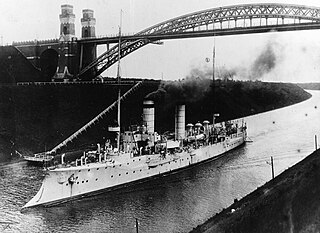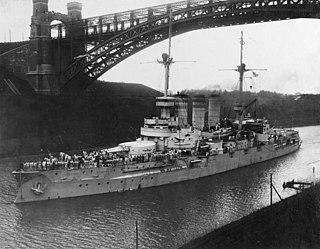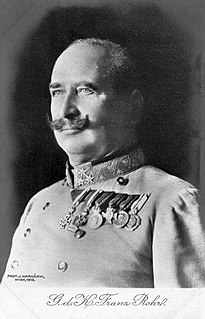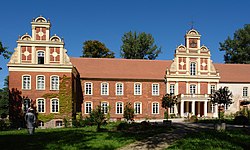
Krokus is a hard rock/heavy metal band from Switzerland. They enjoyed success in North America during the 1980s.

Dalarö is a locality situated in Haninge Municipality, Stockholm County, Sweden with 1,199 inhabitants in 2010.
Rohr im Gebirge is a village in the Wiener Neustadt-Land district of Lower Austria in Austria.

SMS Arcona was the ninth member of the ten-ship Gazelle class of light cruisers that were built for the German Kaiserliche Marine in the late 1890s and early 1900s. The Gazelle class was the culmination of earlier unprotected cruiser and aviso designs, combining the best aspects of both types in what became the progenitor of all future light cruisers of the Imperial fleet. Built to be able to serve with the main German fleet and as a colonial cruiser, she was armed with a battery of ten 10.5 cm (4.1 in) guns and a top speed of 21.5 knots. Arcona was a modified version of the basic Gazelle design, with improved armor and additional coal storage for a longer cruising range.

Rohr is a municipality in the Schmalkalden-Meiningen district in Thuringia.

SMS Roon was the lead ship of her class of armored cruisers built for the German Kaiserliche Marine in the early 1900s as part of a major naval expansion program aimed at strengthening the fleet. The ship was named after Field Marshal Albrecht von Roon. She was built at the Kaiserliche Werft in Kiel, being laid down in August 1902, launched in June 1903, and commissioned in April 1906. The ship was armed with a main battery of four 21 cm (8.3 in) guns and had a top speed of 20.4 knots. Like many of the late armored cruisers, Roon was quickly rendered obsolescent by the advent of the battlecruiser; as a result, her career was limited.
There was significant emigration of Swiss people to the Russian Empire from the late 17th to the late 19th century. Rauber (1985) estimates that a number of 50,000 to 60,000 Swiss lived in Russia between roughly 1700 and 1917.

Albisrieden is a quarter in the district 9 in Zürich.

SMS Lothringen was the last of five pre-dreadnought battleships of the Braunschweig class, built for the German Kaiserliche Marine. She was laid down in December 1902, was launched in May 1904, and was commissioned in May 1906. She was named for the then-German province of Lothringen. The ship was armed with a battery of four 28 cm (11 in) guns and had a top speed of 18 knots. Like all other pre-dreadnoughts built around the turn of the century, Lothringen was quickly made obsolete by the launching of the revolutionary HMS Dreadnought in 1906; as a result, her career as a front-line battleship was cut short.

Franz Freiherr Rohr von Denta was an Austro-Hungarian field marshal and field commander who served as the last commander of the Austro-Hungarian First Army.

A bile duct hamartoma or biliary hamartoma, is a benign tumour-like malformation of the liver.

Hans Joachim von Rohr was a German politician with the German National People's Party.

Hanns von Meyenburg was a Swiss pathologist.
The Meyenburg Prize is awarded for outstanding achievements in cancer research by the Meyenburg Foundation in support of the German Cancer Research Center, Heidelberg (DKFZ), which is the largest biomedical research institution in Germany. The prize has been awarded annually since 1981, and currently has an honorarium of €50,000.

SMS Zieten was the first torpedo-armed aviso built for the Imperial German Navy. She was built in Britain in 1875–1876, and was the last major warship built for Germany by a foreign shipyard. Ordered as a testbed for the new Whitehead torpedo, Zieten was armed with a pair of 38 cm (15 in) torpedo tubes, and was capable of a top speed of 16 knots, making her the fastest ship in the German fleet at the time. Zieten was the first torpedo-armed vessel in a series of avisos that ultimately developed into the first light cruisers. In addition to her impact in German warship design, Zieten also influenced numerous other navies, who built dozens of similar avisos and torpedo vessels of their own.

Willy Martin Ernst Rohr was a German Army officer who was a major contributor to the development of infantry tactics in World War I, particularly for the system of Storm Battalions.
Gertrud Anna Constance Frisch-von Meyenburg (1916–2009) was a Swiss architect and the first wife of the writer Max Frisch.

SMS Mars was an artillery training ship of the German Kaiserliche Marine, built in the late 1870s.















